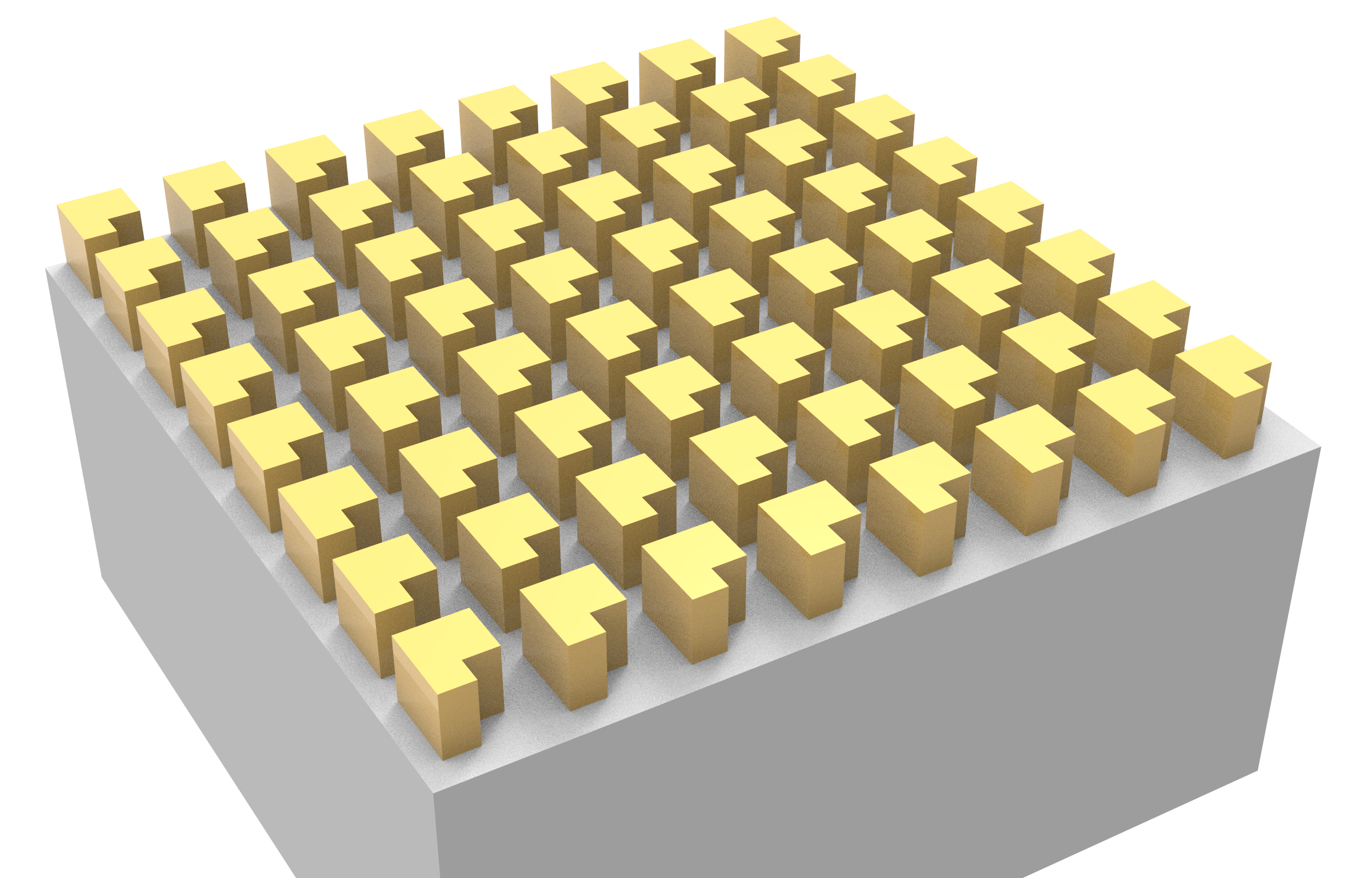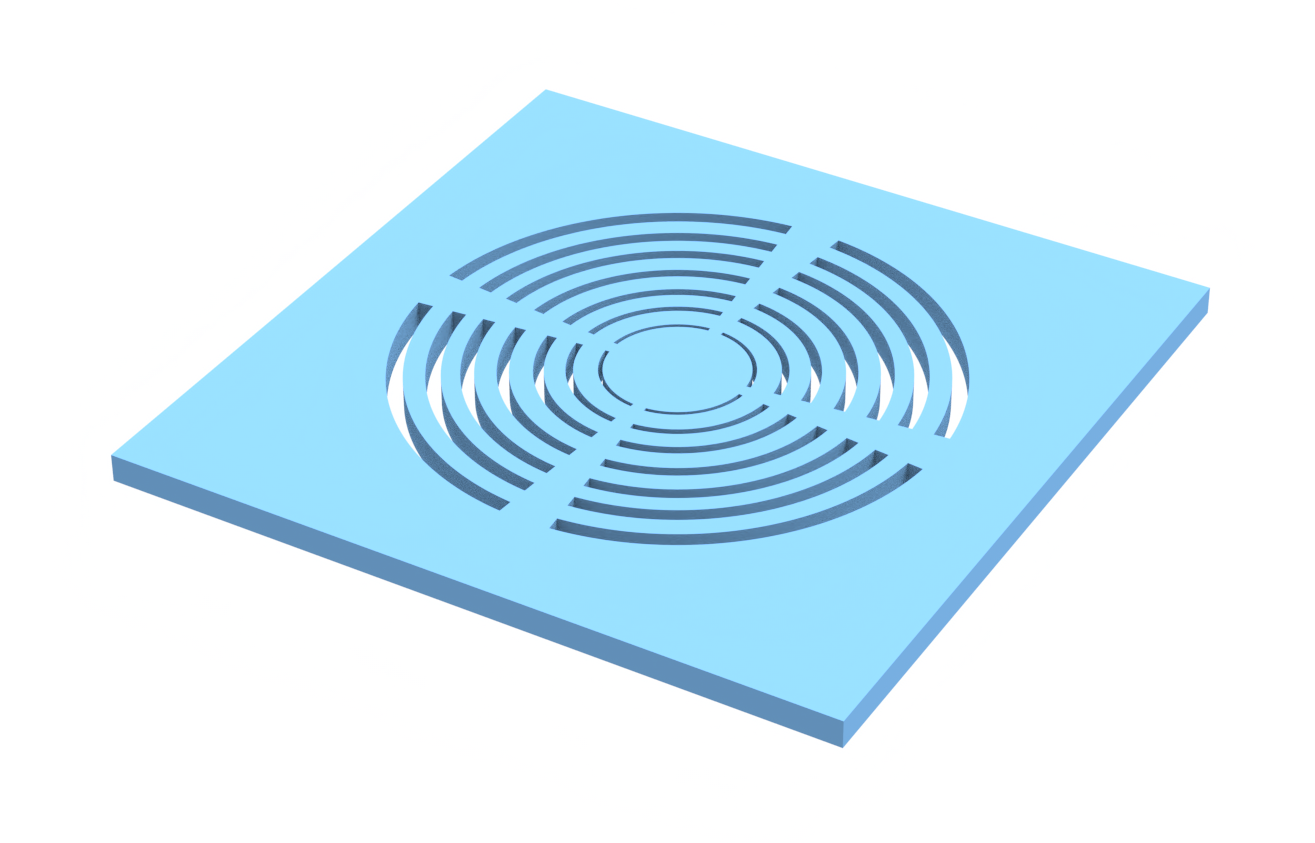Author: Daniil Lukin, Brightlight Photonics
This notebook demonstrates how to use linear fields to calculate the nonlinear polarization and apply it as a source to investigate Second Harmonic Generation (SHG) in a 2D photonic crystal cavity reported in the work of Heungjoon Kim, Bong-Shik Song, Takashi Asano and Susumu Noda, entitled "Enhanced second-harmonic generation in a photonic crystal waveguide-coupled nanocavity using a wavelength-selective reflector", APL Photonics, 2023. DOI: https://doi.org/10.1063/5.0173196
We will achieve this in two steps:
- Run a linear simulation with a
GaussianPulsesource to determine the resonant frequency and resonant fields. - Run a CW simulation exciting the resonance frequency until reach the steady state.
- Use the linear field information to create the nonlinear polarization,
$$P^{(2)}_{i,j,k} = \epsilon_0 d_{i,j,k} E_j E_k$$
transform to current with the relation,
$$P^{(2)}(\vec{r},t) = \frac{\partial J^{(2)}}{\partial t} == -i \omega_{sh} P^{(2)}(\vec{r})$$
and apply it as CustomCurrentSource.
In this notebook, we will explore various features of Tidy3D, such as:
- Anisotropic media.
- Using
ResonanceFinderto extract resonance information from time-domain field monitors efficiently. - Using a
CustomCurrentSource.
This notebook example was kindly shared by the Brightlight Photonics team.
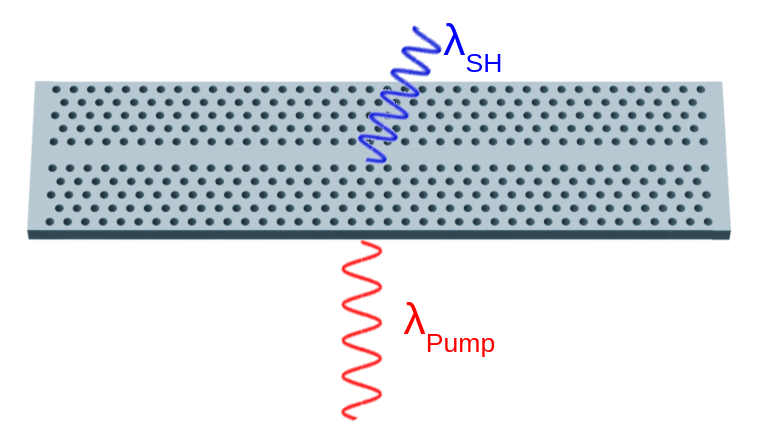
# Standard python imports
import jupyter_black
import matplotlib.pyplot as plt
import numpy as np
import tidy3d as td
from tidy3d import web
from tidy3d.plugins.resonance import ResonanceFinder
jupyter_black.load()
Parameters Definition¶
Here, we define the global parameters for the simulation as well as the anisotropic medium.
# Universal parameters
ep_hole = 1 # Dielectric constant of the holes
n_ordinary_1550nm = 2.564
n_extraordinary_1550nm = 2.608
n_ordinary_775nm = 2.607
n_extraordinary_775nm = 2.65
# Defining anisotropic materials
medium_xx_1550 = td.Medium(permittivity=n_ordinary_1550nm**2)
medium_yy_1550 = td.Medium(permittivity=n_ordinary_1550nm**2)
medium_zz_1550 = td.Medium(permittivity=n_extraordinary_1550nm**2)
mat_slab_1550 = td.AnisotropicMedium(
xx=medium_xx_1550, yy=medium_yy_1550, zz=medium_zz_1550, name="mat_slab"
)
mat_hole_1550 = td.Medium(permittivity=ep_hole, name="mat_hole")
medium_xx_775 = td.Medium(permittivity=n_ordinary_775nm**2)
medium_yy_775 = td.Medium(permittivity=n_ordinary_775nm**2)
medium_zz_775 = td.Medium(permittivity=n_extraordinary_775nm**2)
mat_slab_775 = td.AnisotropicMedium(
xx=medium_xx_775, yy=medium_yy_775, zz=medium_zz_775, name="mat_slab"
)
mat_hole_775 = td.Medium(permittivity=ep_hole, name="mat_hole")
a_lattice = 0.530
r_hole = 0.26
t_slab = 0.57
sidewall_angle = 0
sim_size = Lx, Ly, Lz = (a_lattice * 40, a_lattice * np.sqrt(3) / 2 * 12, 3)
Now we define the photonic crystal cavity geometry.
# potential well on half-integer grid
def sqrt_potential(depth, width, n_max=100, plot=False):
x_points = np.arange(0, n_max, 0.5)
potential = np.sqrt(np.interp(x_points, [0, width, n_max], [depth, 0, 0]))
if plot:
plt.scatter(x_points, potential)
return x_points, potential
# potential well on half-integer grid
def linear_potential(depth, width, n_max=100, plot=False):
x_points = np.arange(0, n_max, 0.5)
potential = np.interp(x_points, [0, width, n_max], [depth, 0, 0])
if plot:
plt.scatter(x_points, potential)
return x_points, potential
def noda_potential(n_max=100):
x_points = np.arange(0, n_max, 0.5)
potential = np.interp(
x_points,
[0, 0.5, 1.5, 2, 2.5, 3, 3.5, n_max],
[0.0094, 0.0094, 0.0047, 0.0047, 0.0047, 0, 0, 0],
)
return x_points, potential
def normed_x_hole_position_from_potential(x, y):
cumsum = np.cumsum(y + 1) * 0.5
return x, cumsum - cumsum[0]
def define_geometry(mat_slab, mat_hole):
vector_1_normed = np.array([1 / 2, np.sqrt(3) / 2])
vector_2_normed = np.array([-1 / 2, np.sqrt(3) / 2])
period_indices, x_position_normed = normed_x_hole_position_from_potential(
*noda_potential()
)
num_periods = 80
sim_lim_x = Lx / 2 - a_lattice / 2
sim_lim_y = Ly / 2 - a_lattice / 2
hole_positions = []
for a1 in np.arange(-num_periods, num_periods):
for a2 in np.arange(-num_periods, num_periods):
normed_lattice_coord = a1 * vector_1_normed + a2 * vector_2_normed
x_lattice_index = normed_lattice_coord[0]
if x_lattice_index < 0:
continue
matches = np.where(period_indices == x_lattice_index)[0]
if len(matches) != 1:
print(x_lattice_index)
continue
final_hole_coord = a_lattice * np.array(
[x_position_normed[matches[0]], normed_lattice_coord[1]]
)
if (
sim_lim_y >= final_hole_coord[1] > 0
and 0 <= final_hole_coord[0] < sim_lim_x
):
hole_positions.append(final_hole_coord)
# reflect along y:
hole_positions_reflected_x = []
for pos in hole_positions:
if pos[0] > a_lattice / 10:
hole_positions_reflected_x.append([-pos[0], pos[1]])
hole_positions.extend(hole_positions_reflected_x)
hole_positions.extend([[pos[0], -pos[1]] for pos in hole_positions])
hole_positions = np.array(hole_positions)
plot = False
if plot:
plt.scatter(hole_positions[:, 0], hole_positions[:, 1])
plt.axis("equal")
# plt.xlim(0, 1)
plt.show()
slab = td.Structure(
geometry=td.Box(
center=(0, 0, 0),
size=(td.inf, td.inf, t_slab * a_lattice),
),
medium=mat_slab,
name="slab",
)
holes = []
for hole_pos in hole_positions:
holes.append(
td.Structure(
geometry=td.Cylinder(
center=(hole_pos[0], hole_pos[1], 0),
axis=2,
radius=r_hole * a_lattice,
length=t_slab * a_lattice,
sidewall_angle=-sidewall_angle * np.pi / 180,
),
medium=mat_hole,
name="hole_" + str(len(holes)),
)
)
structures = [slab] + holes
return structures
structures_list = define_geometry(mat_slab_1550, mat_hole_1550)
Gaussian Pulse Simulation¶
First, we define a PointDipole source with Gaussian time dependency.
# Central frequency around which we'll look for the cavity mode (Hz)
freq0 = 1.908e14
# Source bandwidth (Hz)
fwidth = 4e13
# Simulation run time (s)
run_time = 20e-12
# Plot time dependence to verify when the source pulse decayed
source = td.PointDipole(
center=(0, 0, 0),
source_time=td.GaussianPulse(freq0=freq0, fwidth=fwidth),
polarization="Ey",
)
# Source pulse is much shorter than the simulation run_time defined above,
# so we only examine the signal up to a shorter time = 10e-13fs
fig, ax = plt.subplots(1, 2, figsize=(10, 4))
source.source_time.plot(np.linspace(0, 1e-13, 2000), ax=ax[0])
source.source_time.plot_spectrum(times=np.linspace(0, 5e-13, 2000), ax=ax[1])
plt.show()
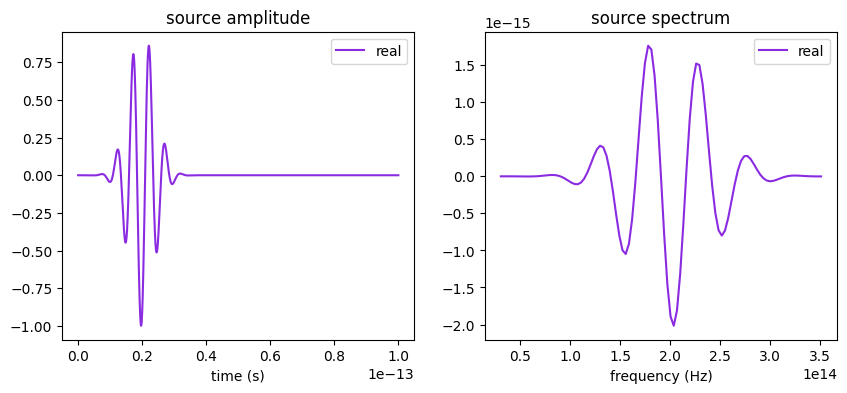
# Suppress warnings for some of the holes being too close to the PML
td.config.logging_level = "ERROR"
refine_box = td.MeshOverrideStructure(
geometry=td.Box(center=(0, 0, 0), size=(td.inf, td.inf, t_slab * a_lattice)),
dl=[None, None, t_slab * a_lattice / 12],
)
# Mesh step in x, y, z, in microns
steps_per_unit_length_xy = 15
steps_per_unit_length_z = 15
grid_spec = td.GridSpec(
grid_x=td.AutoGrid(min_steps_per_wvl=steps_per_unit_length_xy),
grid_y=td.AutoGrid(min_steps_per_wvl=steps_per_unit_length_xy),
grid_z=td.AutoGrid(min_steps_per_wvl=steps_per_unit_length_z),
override_structures=[refine_box],
)
# Starting time after the source has decayed
t_start = 10e-13
# Time series monitor for Q-factor computation
time_series_mnt = td.FieldTimeMonitor(
center=[0, 0, 0], size=[0, 0, 0], start=t_start, name="time_series"
)
# Flux time monitor
flux_time = td.FluxTimeMonitor(
center=(0, 0, 0), size=(0.8 * Lx, 0.8 * Ly, 0.8 * Lz), name="flux_time"
)
eps_monitor = td.PermittivityMonitor(
center=(0, 0, 0), size=(Lx, Ly, Lz), freqs=[freq0], name="eps_monitor"
)
apodization = td.ApodizationSpec(start=t_start, width=2e-13)
field_mnt = td.FieldMonitor(
center=(0, 0, 0),
size=(Lx, Ly, Lz),
name="field_mnt",
freqs=[freq0],
apodization=apodization,
)
sim = td.Simulation(
size=sim_size,
grid_spec=grid_spec,
structures=structures_list,
sources=[source],
monitors=[time_series_mnt, flux_time, field_mnt, eps_monitor],
run_time=run_time,
boundary_spec=td.BoundarySpec(
x=td.Boundary.pml(), y=td.Boundary.pml(), z=td.Boundary.pml()
),
symmetry=(1, -1, 1),
)
# Plot simulation and overlay grid in the xy planes
def plot_sim_grid(sim):
fig, ax = plt.subplots(1, 1, figsize=(12, 6))
sim.plot(z=0, ax=ax, monitor_alpha=0)
sim.plot_grid(x=0, ax=ax, lw=0.4, colors="r")
plt.ylim(-1, 0)
plt.xlim(0, 1)
print(f"Total number of grid points (millions): {sim.num_cells / 1e6:1.2}")
return ax
plot_sim_grid(sim)
plt.show()
Total number of grid points (millions): 6.6
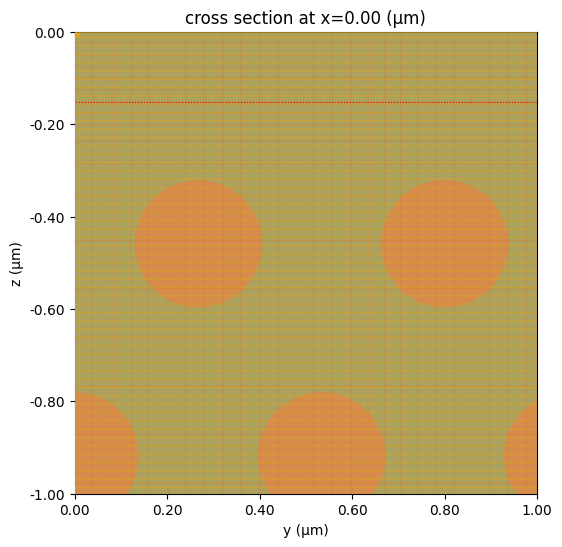
# Visualize simulation
sim.plot_3d()
# Running the simulation
sim_data = web.run(sim, task_name="1_fundamental_mode_spectrum")
20:59:33 -03 Created task '1_fundamental_mode_spectrum' with task_id 'fdve-1ac35438-20c7-465f-8690-ce810e8c5bd7' and task_type 'FDTD'.
View task using web UI at 'https://tidy3d.simulation.cloud/workbench?taskId=fdve-1ac35438-20c 7-465f-8690-ce810e8c5bd7'.
Task folder: 'default'.
Output()
20:59:36 -03 Maximum FlexCredit cost: 0.194. Minimum cost depends on task execution details. Use 'web.real_cost(task_id)' to get the billed FlexCredit cost after a simulation run.
20:59:38 -03 status = queued
To cancel the simulation, use 'web.abort(task_id)' or 'web.delete(task_id)' or abort/delete the task in the web UI. Terminating the Python script will not stop the job running on the cloud.
Output()
20:59:43 -03 status = preprocess
20:59:47 -03 starting up solver
20:59:48 -03 running solver
Output()
21:01:51 -03 status = postprocess
Output()
21:01:55 -03 status = success
21:01:57 -03 View simulation result at 'https://tidy3d.simulation.cloud/workbench?taskId=fdve-1ac35438-20c 7-465f-8690-ce810e8c5bd7'.
Output()
21:02:10 -03 loading simulation from simulation_data.hdf5
eps_non_colocated = abs(sim_data["eps_monitor"].eps_yy).isel(f=0)
eps = eps_non_colocated.interp(
x=sim_data["field_mnt"].Ex.coords["x"],
y=sim_data["field_mnt"].Ex.coords["y"],
z=sim_data["field_mnt"].Ex.coords["z"],
)
ax = sim_data.plot_field(
"field_mnt",
"Ey",
"real",
z=0,
robust=False,
eps_alpha=0,
)
ax.pcolormesh(
eps.x, eps.y, eps.sel(z=0, method="nearest").real.T, alpha=0.2, cmap="binary"
)
plt.show()
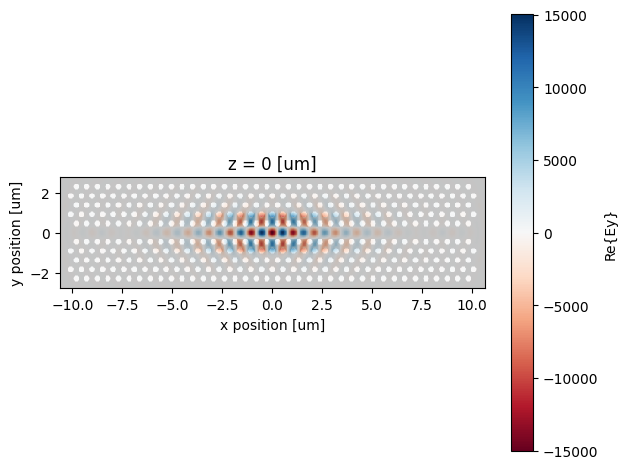
Now, we will analyze the field time series data. As we can see, the resonances exhibit exponential decay, and the cavity resonance is clearly visible in the Fourier transform.
# Get data from the TimeMonitor
tdata = sim_data["time_series"]
time_series = tdata.Ey.squeeze()
fig, (ax1, ax2) = plt.subplots(1, 2, figsize=(10, 3))
# Plot time dependence
time_series.plot(ax=ax1)
# Make frequency mesh and plot spectrum
dt = sim_data.simulation.dt
fmesh = np.linspace(-1 / dt / 2, 1 / dt / 2, time_series.size)
spectrum = np.fft.fftshift(np.fft.fft(time_series))
ax2.plot(fmesh, np.abs(spectrum))
ax2.set_xlim(freq0 - fwidth, freq0 + fwidth)
ax2.set_xlabel("Frequency [Hz]")
ax2.set_ylabel("Electric field [a.u.]")
ax2.set_title("Spectrum")
plt.tight_layout()
plt.show()

Now we can use ResonanceFinder to calculate the resonant frequency and Q-factor:
resonance_finder = ResonanceFinder(
freq_window=(freq0 - fwidth / 2, freq0 + fwidth / 2), init_num_freqs=100
)
resonance_data = resonance_finder.run(sim_data["time_series"])
resonance_data.to_dataframe()
| decay | Q | amplitude | phase | error | |
|---|---|---|---|---|---|
| freq | |||||
| 1.916514e+14 | 1.265659e+10 | 47571.325619 | 676.657889 | 0.715587 | 0.000618 |
| 1.921427e+14 | 2.446458e+11 | 2467.380475 | 76.432467 | -2.481902 | 0.000839 |
| 1.926705e+14 | 7.228575e+11 | 837.360110 | 82.764169 | 0.594612 | 0.002911 |
| 1.934497e+14 | 1.414883e+12 | 429.533819 | 46.411220 | 2.004166 | 0.021042 |
cavity_resonance_freq = float(resonance_data.freq[0])
CW Run¶
Now, we will run a CW simulation at the resonance frequency until the fields reach a steady state. Then, we will record the fields and use them in the calculation of the nonlinear polarization.
run_time_cw = 1e-10
field_mnt_time = td.FieldTimeMonitor(
center=(0, 0, 0),
size=(Lx, Ly, Lz),
fields=["Ex", "Ey", "Ez"],
start=run_time_cw - 1 / freq0,
interval=1,
colocate=True,
name="movie_monitor",
)
sim_cw = sim.updated_copy(
sources=(
td.PointDipole(
center=(0, 0, 0),
source_time=td.ContinuousWave(freq0=cavity_resonance_freq, fwidth=fwidth),
polarization="Ey",
),
),
monitors=list(sim.monitors) + [field_mnt_time],
run_time=run_time_cw,
)
sim_data_cw = web.run(sim_cw, task_name="1_fundamental_mode_spectrumCW")
21:02:14 -03 Created task '1_fundamental_mode_spectrumCW' with task_id 'fdve-8db353fb-06d6-4282-81e2-8f02a9c287c2' and task_type 'FDTD'.
View task using web UI at 'https://tidy3d.simulation.cloud/workbench?taskId=fdve-8db353fb-06d 6-4282-81e2-8f02a9c287c2'.
Task folder: 'default'.
Output()
21:02:17 -03 Maximum FlexCredit cost: 0.995. Minimum cost depends on task execution details. Use 'web.real_cost(task_id)' to get the billed FlexCredit cost after a simulation run.
21:02:19 -03 status = queued
To cancel the simulation, use 'web.abort(task_id)' or 'web.delete(task_id)' or abort/delete the task in the web UI. Terminating the Python script will not stop the job running on the cloud.
Output()
21:02:26 -03 status = preprocess
21:02:31 -03 starting up solver
running solver
Output()
21:12:16 -03 status = postprocess
Output()
21:13:03 -03 status = success
21:13:05 -03 View simulation result at 'https://tidy3d.simulation.cloud/workbench?taskId=fdve-8db353fb-06d 6-4282-81e2-8f02a9c287c2'.
Output()
21:14:40 -03 loading simulation from simulation_data.hdf5
# Get data from the TimeMonitor
tdata = sim_data_cw["time_series"]
time_series = tdata.Ey.squeeze()
# Get data from the TimeMonitor
tdata_flux = sim_data_cw["flux_time"]
flux = tdata_flux.flux.squeeze()
time_flux = tdata_flux.flux.coords["t"]
fig, (ax1, ax2, ax3) = plt.subplots(1, 3, figsize=(10, 3))
# Plot time dependence
time_series.plot(ax=ax1)
# Make frequency mesh and plot spectrum
dt = sim_data_cw.simulation.dt
fmesh = np.linspace(-1 / dt / 2, 1 / dt / 2, time_series.size)
spectrum = np.fft.fftshift(np.fft.fft(time_series))
ax2.plot(fmesh, np.abs(spectrum))
ax2.set_xlim(freq0 - 2 * fwidth, freq0 + 2 * fwidth)
ax2.set_xlabel("Frequency [Hz]")
ax2.set_ylabel("Electric field [a.u.]")
ax2.set_title("Spectrum")
ax3.plot(time_flux, np.abs(flux))
plt.tight_layout()
plt.show()

max_field_coord = sim_data_cw["movie_monitor"].Ey.idxmax(dim="t")
Ey_array = np.array(sim_data_cw["movie_monitor"].Ey)
integrated_ey_time = np.sum(Ey_array, axis=(0, 1, 2))
time_coord_max_field = np.argmax(integrated_ey_time)
Ex = sim_data_cw["movie_monitor"].Ex.isel(t=time_coord_max_field).drop("t")
Ey = sim_data_cw["movie_monitor"].Ey.isel(t=time_coord_max_field).drop("t")
Ez = sim_data_cw["movie_monitor"].Ez.isel(t=time_coord_max_field).drop("t")
/tmp/ipykernel_28045/4225370433.py:1: DeprecationWarning: dropping variables using `drop` is deprecated; use drop_vars.
Ex = sim_data_cw["movie_monitor"].Ex.isel(t=time_coord_max_field).drop("t")
/tmp/ipykernel_28045/4225370433.py:2: DeprecationWarning: dropping variables using `drop` is deprecated; use drop_vars.
Ey = sim_data_cw["movie_monitor"].Ey.isel(t=time_coord_max_field).drop("t")
/tmp/ipykernel_28045/4225370433.py:3: DeprecationWarning: dropping variables using `drop` is deprecated; use drop_vars.
Ez = sim_data_cw["movie_monitor"].Ez.isel(t=time_coord_max_field).drop("t")
The SHG will only occur in the nonlinear medium, so we will create a mask to exclude the holes.
# Permittivity distribution.
eps_non_colocated = abs(sim_data_cw["eps_monitor"].eps_yy).isel(f=0)
eps = eps_non_colocated.interp(
x=Ex.coords["x"],
y=Ex.coords["y"],
z=Ex.coords["z"],
)
eps_max = np.max(np.real(eps))
nonlinear_material_mask = np.real(eps) - 1
nonlinear_material_mask = nonlinear_material_mask / np.max(nonlinear_material_mask)
tdata_flux_w0 = sim_data_cw["flux_time"]
flux_w0 = tdata_flux_w0.flux.squeeze()
radiated_power = float(np.mean(flux_w0[int(len(flux_w0) * 0.99) : -1]))
# Compute energy in cavity
integrand = eps * (
Ex * np.conjugate(Ex) + Ey * np.conjugate(Ey) + Ez * np.conjugate(Ez)
)
integrated_energy = td.EPSILON_0 / 2 * integrand.integrate(coord=("x", "y", "z")).item()
Q = (integrated_energy / radiated_power) * 2 * np.pi * cavity_resonance_freq
print(Q)
47623.6432485041
Second Harmonic Simulation¶
Defining the relevant polarization tensor
# Calculating the second-order nonlinear polarization
d15 = 6.7 * 1e-6 # um/V
d31 = 6.5 * 1e-6 # um/V
d33 = -11.7 * 1e-6 # um/V
# Central frequency around which we'll look for the cavity mode (Hz)
freq_SH = 2 * cavity_resonance_freq
Now, we will define the relevant polarization fields using the relation: $P_{i,j,k} = \omega_0 \epsilon_0 d_{i,j,k} E_j E_k$.
Pxxz = td.EPSILON_0 * d15 * nonlinear_material_mask * Ex * Ez
Pyyz = td.EPSILON_0 * d15 * nonlinear_material_mask * Ey * Ez
Pzxx = td.EPSILON_0 * d31 * nonlinear_material_mask * Ex * Ex
Pzyy = td.EPSILON_0 * d31 * nonlinear_material_mask * Ey * Ey
Pzzz = td.EPSILON_0 * d33 * nonlinear_material_mask * Ez * Ez
Pxxz = Pxxz.expand_dims(dim={"f": 1}, axis=3)
Pyyz = Pyyz.expand_dims(dim={"f": 1}, axis=3)
Pzxx = Pzxx.expand_dims(dim={"f": 1}, axis=3)
Pzyy = Pzyy.expand_dims(dim={"f": 1}, axis=3)
Pzzz = Pzzz.expand_dims(dim={"f": 1}, axis=3)
Pxxz = Pxxz.assign_coords(f=[freq_SH])
Pyyz = Pyyz.assign_coords(f=[freq_SH])
Pzxx = Pzxx.assign_coords(f=[freq_SH])
Pzyy = Pzyy.assign_coords(f=[freq_SH])
Pzzz = Pzzz.assign_coords(f=[freq_SH])
Finally, we create the polarization dataset to be used in the CustomCurrentSource
factor = -1j * (freq_SH * 2 * np.pi)
polarization = td.FieldDataset(
Ex=factor * Pxxz,
Ey=factor * Pyyz,
Ez=factor * (Pzxx + Pzyy + Pzzz),
)
# Source bandwidth (Hz)
fwidth_SH = freq_SH * 0.3
# Simulation run time (s)
run_time_SH = 2e-12
# In-built GaussianBeam source
pulse = td.ContinuousWave(freq0=freq_SH, fwidth=fwidth_SH)
custom_src_JM = td.CustomCurrentSource(
source_time=pulse,
center=(0, 0, 0),
size=(Lx, Ly, Lz),
current_dataset=polarization,
)
structures_775 = define_geometry(mat_slab_775, mat_hole_775)
simSH = td.Simulation(
size=sim.size,
grid_spec=td.GridSpec.from_grid(
sim.grid
), # Reference to the linear simulation for copying the grid
structures=structures_775,
sources=[custom_src_JM],
monitors=[time_series_mnt, eps_monitor, flux_time, field_mnt],
run_time=run_time_SH,
boundary_spec=td.BoundarySpec(
x=td.Boundary.pml(), y=td.Boundary.pml(), z=td.Boundary.pml()
),
symmetry=(0, 0, 0),
shutoff=0,
)
sim_data_SH = web.run(simSH, task_name="no name", verbose=True)
21:15:19 -03 Created task 'no name' with task_id 'fdve-c9d00a4e-448e-4e26-a2f4-5df4ce520afe' and task_type 'FDTD'.
View task using web UI at 'https://tidy3d.simulation.cloud/workbench?taskId=fdve-c9d00a4e-448 e-4e26-a2f4-5df4ce520afe'.
Task folder: 'default'.
Output()
21:15:51 -03 Maximum FlexCredit cost: 0.095. Minimum cost depends on task execution details. Use 'web.real_cost(task_id)' to get the billed FlexCredit cost after a simulation run.
21:15:53 -03 status = queued
To cancel the simulation, use 'web.abort(task_id)' or 'web.delete(task_id)' or abort/delete the task in the web UI. Terminating the Python script will not stop the job running on the cloud.
Output()
21:15:58 -03 status = preprocess
21:16:07 -03 starting up solver
running solver
Output()
21:16:42 -03 status = postprocess
Output()
21:16:58 -03 status = success
21:17:00 -03 View simulation result at 'https://tidy3d.simulation.cloud/workbench?taskId=fdve-c9d00a4e-448 e-4e26-a2f4-5df4ce520afe'.
Output()
21:17:38 -03 loading simulation from simulation_data.hdf5
As we can see in the plots above, the fields reach a steady-state after about 0.5 ps.
Now, we can visualize the SHG fields from the resonant mode:
# Get data from the TimeMonitor
tdata = sim_data_SH["time_series"]
time_series = tdata.Ez.squeeze()
# Get data from the TimeMonitor
tdata_flux = sim_data_SH["flux_time"]
flux = tdata_flux.flux.squeeze()
time_flux = tdata_flux.flux.coords["t"]
fig, (ax1, ax2, ax3) = plt.subplots(1, 3, figsize=(10, 3))
# Plot time dependence
time_series.plot(ax=ax1)
# Make frequency mesh and plot spectrum
dt = sim_data_SH.simulation.dt
fmesh = np.linspace(-1 / dt / 2, 1 / dt / 2, time_series.size)
spectrum = np.fft.fftshift(np.fft.fft(time_series))
ax2.plot(fmesh, np.abs(spectrum))
ax2.set_xlim(2 * freq0 - 2 * fwidth, 2 * freq0 + 2 * fwidth)
ax2.set_xlabel("Frequency [Hz]")
ax2.set_ylabel("Electric field [a.u.]")
ax2.set_title("Spectrum")
ax3.plot(time_flux, np.abs(flux))
plt.tight_layout()
plt.show()

ax = sim_data_SH.plot_field(
"field_mnt", "Ez", "real", z=0, robust=False, eps_alpha=0, phase=np.pi
)
ax.pcolormesh(
eps.x, eps.y, eps.sel(z=0, method="nearest").real.T, alpha=0.2, cmap="binary"
)
plt.show()















